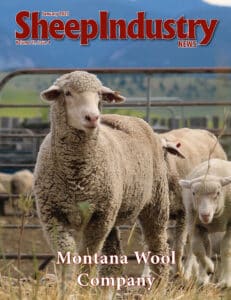Idaho’s Jeff Siddoway became the second member of his family to be selected as the winner of ASI’s McClure Silver Ram Award when he was chosen from a group of top-notch nominees as the 2023 recipient. His wife, Cindy – a past president of ASI – won the award in 2016.
Siddoway leads a slate of award winners that is second to none. He’ll be honored at the Industry Awards Luncheon on Jan. 20, at the ASI Annual Convention in Fort Worth, Texas. He’ll be joined on stage that day by:
• Distinguished Producer Award winner Dr. Stanley Poe of Indiana.
• Peter Orwick Camptender Award winners Jim Logan, DVM, of Wyoming,
and Cindy Wolf, DVM, of Minnesota.
• Industry Innovation Award winner Jeanne Carver of Oregon.
• Shepherd’s Voice Award winner KLST-TV/KSAN-TV of San Angelo, Texas.
McClure Silver Ram
A fifth-generation Idaho sheep rancher, Siddoway made his mark while serving 12 years in the Idaho State Senate.
He was also a regular participant in ASI’s Spring Trip to Washington, D.C., where he lobbied Congress on behalf of the industry. Siddoway ventured into politics “to protect agriculture,” and worked fervently on issues ranging from predator management to keeping the doors open at the U.S. Sheep Experiment Station in Dubois, Idaho.
“We worked long and hard to save the station,” he said. “We almost saw its demise, but I’m proud to say it’s still going strong. I do look at some of our wins in Washington, D.C., and I’m thankful for those.”
Siddoway served on a variety of ASI’s councils and committees through the years, including a stint on the ASI Board of Directors. He’s also a past president of the Idaho Wool Growers Association.
“I just love the people in this industry and the industry itself,” he said. “We don’t always agree on everything, but we find a way to come together and move the industry forward. I wish I could say the industry was a little stronger than it is, but I think the next generation is going to do some great things with the sheep industry.”
As for winning the McClure Silver Ram Award, Siddoway said he could think of plenty of other producers who are just as (or more) deserving of the recognition.
“This was quite a surprise,” said Siddoway. “I’m humbled just to be nominated, much less to receive the award.”
Distinguished Producer
Dr. Stanley Poe is a lifelong sheep producer who was fortunate enough to work with both his father and his children in the family’s Hampshire operation. He was happy to hand over the operation to the next generation in the last year.
“I appreciate the fact that I didn’t have to have a dispersal sale when I decided it was time to retire,” he said. “I don’t really have much work to do around the farm now, but a lot of the sheep producers I worked with through the years admire the fact that I have sons who are just as interested in sheep as I was.”
Poe ramped up involvement with ASI after retiring from full-time work with an animal health company in 2000. The family operation was a leader in artificial insemination in the sheep industry and even hosted the ASI Executive Board for a farm tour several years ago. Poe is a past president of the Indiana Sheep Association and has regularly served as the state’s representative to the ASI Board of Directors.
Peter Orwick Camptender
Longtime ASI Animal Health Committee Co-Chairs Jim Logan, DVM, and Cindy Wolf, DVM, have provided an ideal balance of leadership for nearly 30 years, dating back to 1995.
“I had the regulatory experience where she was coming in with the education and teaching experience,” Logan said. “We just always seemed to work well together.”
Logan retired in 2021 from his position as the Wyoming state vet. While he raised sheep much of his life, he mostly dispersed the flock in 2012 to concentrate on his veterinarian duties.
“My family had sheep, my in-laws had sheep, so that was what we did,” he said. “I was a sheep producer from the time I was just a kid. The sheep were always important to me.”
But just as important was the leadership role he took, which allowed him to join Wolf in guiding animal health discussions for the entire American sheep industry.
“I am honored and appreciative to receive this award with my omniscient colleague and dear friend, Dr. Jim Logan,” said Wolf. “I am also grateful of having had the opportunity to work with talented ASI staff and fellow sheep producers from all over the United States. I also want to recognize my family who have supported me throughout my years of volunteer service to the sheep industry.”
According to a nomination form, Wolf started her internship at the University of Minnesota in 1984 with an interest in large animal medicine, specifically dairy cattle. But she cultivated knowledge in small ruminants while there and quickly became an advocate in the sheep and goat communities.
Industry Innovation
Jeanne Carver has been making her own way in the wool market for the better part of 25 years. Along the way, she’s provided wool for use in uniforms for the U.S. Olympic Team among other high-profile clients. Her Oregon ranch was the first to be certified under the Responsible Wool Standard – a third-party certification program.
In 2018, she started Shaniko Wool Company to scale up the supply of RWS-certified American wool. There are now 10 Western sheep producer members of the company. All totaled they run sheep on more than 2.5 million acres and shear more than 500,000 pounds of wool each year.
“These growers are the reason I’m receiving this award,” Carver said. “I’m speechless, but very honored and humbled by this recognition. The ranchers who are a part of Shaniko Wool are leaders at both the national and state levels of our industry.”
Carver said she pursued RWS certification because a potential wool customer asked her to. And now all of the producers under the company banner are annually receiving a premium price for their wool as consumers continue to push for more information on how their food and fiber is produced.
“I never knew where this road would go, but I just kept working,” Carver said. “I never dreamed I would get recognized by our national association for my work.”
Shepherd’s Voice
KLST/KSAN-TV of San Angelo, Texas, “considers it an honor to tell farmers’ and ranchers’ stories.” The station bridges the gap between viewers who aren’t familiar with agriculture and those who have been involved with the industry for generations.
The station will be honored with ASI’s Shepherd’s Voice Award that is presented annually to members of the media who cover the American sheep industry throughout the year.
In early 2022, the station told the story of Tanner Lott, whose mother passed away just before the San Angelo Stock Show in February. At the Annual Premium Sale, Lott’s lamb sold for $20,500 after “pretty much every person in attendance” pitched in.
“While we understand that not all of the stories we tell are specific to the sheep industry, we hope you will take our station into consideration for attempting to bring the importance of the ag industry to light,” wrote KLST’s Senora Scott.



